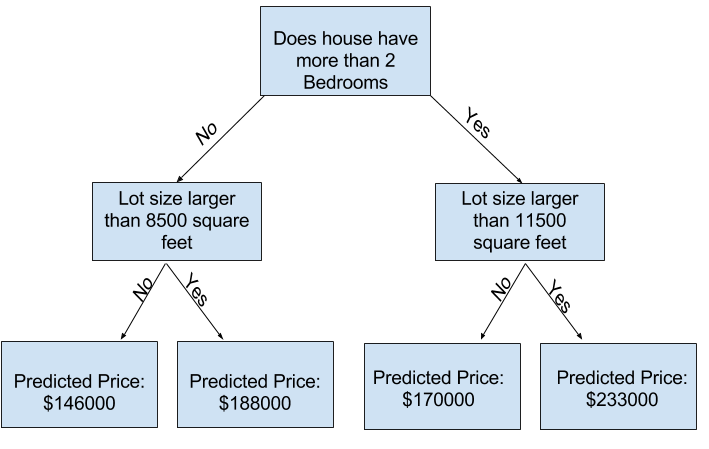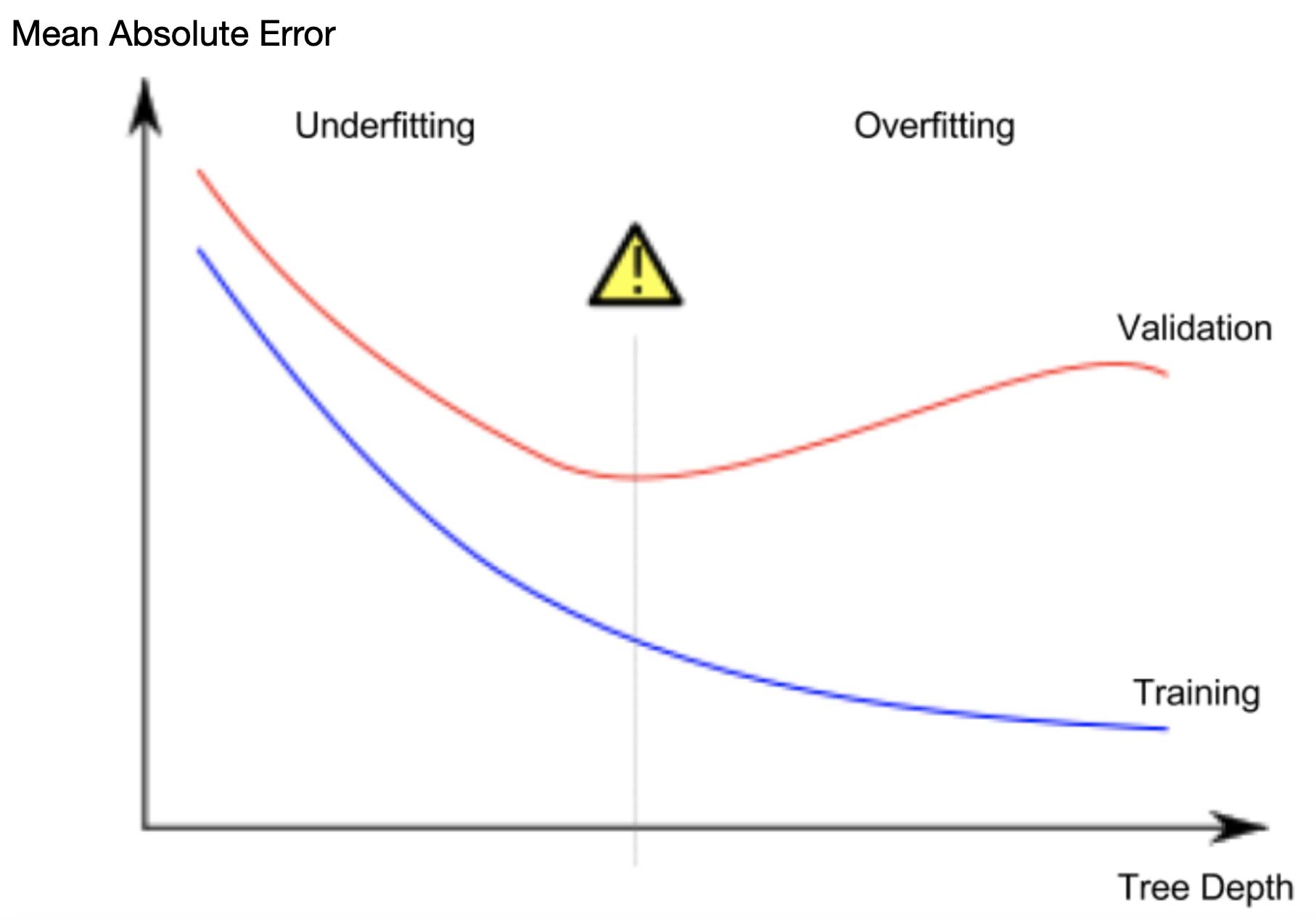笔记:机器学习的基本工具 本文介绍机器学习的基本 Python 工具和流程。所用算法包括决策树(Decision Tree)、随机森林(Random Forest)和 XGBoost。
基于 Kaggle 教程 Intro to Machine Learning 和 Intermediate Machine Learning 。
预备知识
变量的类型
Categorical:人为定义的类别
Ordinal:有序类别(e.g. Size: S < M < L)
Nominal:无序类别(e.g. Color: Red, Green, Blue)
Numerical:测量值
Discrete:离散取值,一般为整数
Continuous:连续取值
Pandas
参考 Pandas 的常用操作 这篇笔记。
预处理
令完整数据集为 home_data,我们将其按 80:20 的比例分为 train 和 validation 两部分。test 数据集为 test_data。
令输入特征为 features,目标变量为 y。
1 2 3 4 5 6 7 8 9 from sklearn.model_selection import train_test_splithome_data = pd.read_csv('data/train.csv' ) features = ['LotArea' , 'YearBuilt' , '1stFlrSF' , '2ndFlrSF' , 'FullBath' , 'BedroomAbvGr' , 'TotRmsAbvGrd' ] X = home_data[features] y = home_data.SalePrice train_X, val_X, train_y, val_y = train_test_split(X, y, random_state=0 )
指定 random_state 会使结果可复现。
决策树 & 随机森林
决策树:将样本根据特征 (e.g. LotArea >= 11500 vs LotArea < 11500) 分为两类,然后递归划分所有子集,直到深度达到阈值,或者每个叶子节点的样本数都小于阈值。将每个子集中所有样本的 y 的平均值作为预测值。
伪代码:
1 2 3 4 5 6 7 8 9 10 11 12 def decision_tree (X, y ): if stopping_condition(X, y): return leaf_value(y) else : split_feature, split_value = find_best_split(X, y) X_left, y_left, X_right, y_right = split(X, y, split_feature, split_value) return { 'split_feature' : split_feature, 'split_value' : split_value, 'left' : decision_tree(X_left, y_left), 'right' : decision_tree(X_right, y_right) }
随机森林:建立多个决策树,每个决策树都是随机生成的。最终预测值为所有决策树的平均值。
1 2 3 4 5 6 7 8 9 10 11 12 13 14 15 16 from sklearn.tree import DecisionTreeRegressorfrom sklearn.ensemble import RandomForestRegressorfrom sklearn.metrics import mean_absolute_errordef get_mae (model, train_X, val_X, train_y, val_y ): model.fit(train_X, train_y) preds_val = model.predict(val_X) return mean_absolute_error(val_y, preds_val) dt_model = DecisionTreeRegressor() print (get_mae(dt_model, train_X, val_X, train_y, val_y))rf_model = RandomForestRegressor(n_estimators=100 ) print (get_mae(rf_model, train_X, val_X, train_y, val_y))
MAE (Mean Absolute Error): M A E ( y , y ^ ) = 1 n ∑ i = 1 n ∣ y i − y ^ i ∣ MAE(y, \hat{y}) = \frac{1}{n} \sum_{i=1}^{n} |y_i - \hat{y}_i| M A E ( y , y ^ ) = n 1 ∑ i = 1 n ∣ y i − y ^ i ∣
mean_absolute_error(y_true, y_pred)
RMSE (Root Mean Squared Error): R M S E ( y , y ^ ) = 1 n ∑ i = 1 n ( y i − y ^ i ) 2 RMSE(y, \hat{y}) = \sqrt{\frac{1}{n} \sum_{i=1}^{n} (y_i - \hat{y}_i)^2} RMSE ( y , y ^ ) = n 1 ∑ i = 1 n ( y i − y ^ i ) 2
sqrt(mean_squared_error(y_true, y_pred))
过拟合 & 欠拟合
绘制 MAE(train) 和 MAE(validation) 随模型复杂度的变化图,可以看出模型的过拟合和欠拟合情况。
预期情况:MAE(train) 和 MAE(validation) 都下降,但 MAE(validation) 下降速度变慢。
过拟合:MAE(train) 下降,MAE(validation) 上升,表示模型受到训练数据中的噪声影响。
欠拟合:MAE(train) 和 MAE(validation) 都很高。
在决策树中,模型复杂度受 max_leaf_nodes 和 max_depth 制约。(只能设置其中一个)
在随机森林中,n_estimators 越大,模型复杂度越高。
常用参数
n_estimators:决策树的数量criterion:划分特征的标准
默认 squared_error (MSE),用叶子结点的平均值作为预测值,最小化 L2 loss
可选 absolute_error (MAE),用叶子结点的中位数作为预测值,最小化 L1 loss
max_depth:决策树的最大深度max_leaf_nodes:叶子结点的最大数量min_samples_split:如果一个结点的样本数小于该值,则不再划分(默认值为 2)splitter:划分特征的策略(默认值为 best,即选择最佳划分;可选 random)max_features:每次划分时考虑的特征数量(默认值等于 n_features,即考虑所有特征)
数据处理
缺失值
选出有缺失值的列:
1 2 missing_val_count_by_column = (X_train.isnull().sum ()) print (missing_val_count_by_column[missing_val_count_by_column > 0 ])
处理缺失值:
(1) 删除有缺失值的列:
1 2 3 4 cols_with_missing = [col for col in X_train.columns if X_train[col].isnull().any ()] reduced_X_train = X_train.drop(cols_with_missing, axis=1 ) reduced_X_valid = X_valid.drop(cols_with_missing, axis=1 )
(2) 填充缺失值:
1 2 3 4 5 6 7 8 9 10 11 12 13 from sklearn.impute import SimpleImputerimputer = SimpleImputer( strategy='mean' , ) imputed_X_train = pd.DataFrame(imputer.fit_transform(X_train)) imputed_X_valid = pd.DataFrame(imputer.transform(X_valid)) imputed_X_train.columns = X_train.columns imputed_X_valid.columns = X_valid.columns
注意 strategy 的选择:ordinal 变量可能不适合用均值填充。(e.g. YearBuilt 应该用 most_frequent 或 constant)
如果有非常少量的缺失值,可以使用 X_train.dropna() 删除行或 X_train.fillna(0) 填充缺失值。
注意 fit_transform 和 transform 的区别:fit_transform 会在训练集上计算均值,然后将这个结果保存到 imputer 中,再在训练集和验证集上用同样的均值填充缺失值。(如果分开处理,会导致训练集和验证集的填充值不一致)
(3) 填充并标记缺失值:
1 2 3 4 5 6 7 8 9 10 11 X_train_plus = X_train.copy() X_valid_plus = X_valid.copy() for col in cols_with_missing: X_train_plus[col + '_was_missing' ] = X_train_plus[col].isnull() X_valid_plus[col + '_was_missing' ] = X_valid_plus[col].isnull() imputer = SimpleImputer()
类别变量
查看类别变量:
1 2 s = (X_train.dtypes == 'object' ) object_cols = list (s[s].index)
处理类别变量:
(1) 删除类别变量:
1 2 drop_X_train = X_train.select_dtypes(exclude=['object' ]) drop_X_valid = X_valid.select_dtypes(exclude=['object' ])
(2) Ordinal Encoding:将有序类别映射为整数。
1 2 3 4 5 6 7 8 from sklearn.preprocessing import OrdinalEncoderlabel_X_train = X_train.copy() label_X_valid = X_valid.copy() ordinal_encoder = OrdinalEncoder() label_X_train[object_cols] = ordinal_encoder.fit_transform(X_train[object_cols]) label_X_valid[object_cols] = ordinal_encoder.transform(X_valid[object_cols])
OrdinalEncoder 会按照类别出现的顺序进行编码。因此,结果可能无关类别的实际含义。
注意:如果验证集中出现了训练集中没有的类别,transform 会报错。
e.g.
1 2 Unique values in 'Condition2' column in training data: ['Norm' 'PosA' 'Feedr' 'PosN' 'Artery' 'RRAe'] Unique values in 'Condition2' column in validation data: ['Norm' 'RRAn' 'RRNn' 'Artery' 'Feedr' 'PosN']
由于 RRAn, RRNn 在训练集中没有,需要处理未知类别:
(a) 删除在验证集中出现未知类别的列:
1 2 3 4 5 6 object_cols = [col for col in X_train.columns if X_train[col].dtype == 'object' ] good_label_cols = [col for col in object_cols if set (X_valid[col]).issubset(X_train[col])] bad_label_cols = list (set (object_cols) - set (good_label_cols)) label_X_train = X_train.drop(bad_label_cols, axis=1 ) label_X_valid = X_valid.drop(bad_label_cols, axis=1 )
(b) 使用 handle_unknown='use_encoded_value', unknown_value=<value> 将未知类别映射为默认值。
1 ordinal_encoder = OrdinalEncoder(handle_unknown='use_encoded_value' , unknown_value=-1 )
(3) One-Hot Encoding:将无序类别映射为二进制向量(e.g. (Red, Green, Blue) → (1, 0, 0), (0, 1, 0), (0, 0, 1))。
1 2 3 4 5 6 7 8 9 10 11 12 13 14 15 16 17 18 19 20 21 from sklearn.preprocessing import OneHotEncoderOH_encoder = OneHotEncoder(handle_unknown='ignore' , sparse=False ) OH_cols_train = pd.DataFrame(OH_encoder.fit_transform(X_train[object_cols])) OH_cols_valid = pd.DataFrame(OH_encoder.transform(X_valid[object_cols])) OH_cols_train.index = X_train.index OH_cols_valid.index = X_valid.index num_X_train = X_train.drop(object_cols, axis=1 ) num_X_valid = X_valid.drop(object_cols, axis=1 ) OH_X_train = pd.concat([num_X_train, OH_cols_train], axis=1 ) OH_X_valid = pd.concat([num_X_valid, OH_cols_valid], axis=1 ) OH_X_train.columns = OH_X_train.columns.astype(str ) OH_X_valid.columns = OH_X_valid.columns.astype(str )
OneHotEncoder.transform 返回的是稀疏矩阵,需要转换为 DataFrame。
使用 handle_unknown='ignore' 将未知类别映射为全 0 向量。
Cardinality:类别变量的不同取值数量。当 Cardinality 较高时,One-Hot Encoding 会导致维度爆炸。
查看所有类别变量的 Cardinality:
1 2 3 4 5 6 object_nunique = list (map (lambda col: X_train[col].nunique(), object_cols)) d = dict (zip (object_cols, object_nunique)) sorted (d.items(), key=lambda x: x[1 ])
e.g.
1 2 3 4 5 6 7 8 9 object_nunique = [5 , 2 , 4 , 4 , ... ] object_cols = ['MSZoning' , 'Street' , 'LotShape' , 'LandContour' , ... ] d = { 'MSZoning' : 5 , 'Street' : 2 , 'LotShape' : 4 , 'LandContour' : 4 , ... }
高 Cardinality 的类别变量可以删除或改为使用 Ordinal Encoding。
数据泄漏
数据泄漏:训练集中的特征包含了目标变量的信息,导致模型在验证集上表现良好,但在实际应用中表现糟糕。
分为两种情况:
Target Leakage:训练集中包含了在预测时间点之后才能获得的信息,导致目标变量和特征之间存在关联
Train-Test Contamination:验证集影响了模型的训练过程(e.g. 对验证集进行 fit_transform,导致模型中包含了验证集的信息)
辨别数据泄漏:皮尔森相关系数(Pearson Correlation Coefficient)。
1 2 3 4 5 6 7 import seaborn as snsimport matplotlib.pyplot as pltcor = data.corr(method='pearson' ) plt.figure(figsize=(12 , 10 )) sns.heatmap(cor, annot=True , cmap='YlGnBu' ) plt.show()
注意:两个变量之间的相关性 ≠ 两个变量之间的因果关系。
模型构建工具
Pipeline
Pipeline 将数据处理的步骤封装为一个整体,方便在不同数据集上重复使用。
1 2 3 4 5 6 7 8 9 10 11 12 13 14 15 16 17 18 19 20 21 22 23 24 25 26 27 28 29 from sklearn.compose import ColumnTransformerfrom sklearn.pipeline import Pipelinenumercial_transformer = SimpleImputer(strategy='constant' ) categorical_transformer = Pipeline(steps=[ ('imputer' , SimpleImputer(strategy='most_frequent' )), ('onehot' , OneHotEncoder(handle_unknown='ignore' )) ]) preprocessor = ColumnTransformer( transformers=[ ('num' , numercial_transformer, numerical_cols), ('cat' , categorical_transformer, categorical_cols) ] ) model = RandomForestRegressor(n_estimators=100 , random_state=0 ) clf = Pipeline(steps=[ ('preprocessor' , preprocessor), ('model' , model) ]) clf.fit(X_train, y_train)
参数调优
Grid Search:遍历参数空间,找到最优参数。
1 2 3 4 5 6 7 8 9 10 11 12 13 14 15 from sklearn.model_selection import GridSearchCVparam_grid = { 'preprocessor__num__strategy' : ['mean' , 'median' ], 'preprocessor__cat__imputer__strategy' : ['most_frequent' , 'constant' ], 'model__n_estimators' : [100 , 200 , 300 ], 'model__max_depth' : [6 , 8 , 10 , 12 ] } grid_search = GridSearchCV(clf, param_grid, cv=5 ) grid_search.fit(X_train, y_train) print (grid_search.best_params_)preds = grid_search.predict(X_valid) print ('MAE:' , mean_absolute_error(y_valid, preds))
交叉验证
如果训练集和验证集的划分方式影响了模型的性能评估,可以使用交叉验证。
交叉验证不使用固定的验证集,而是将训练集分为 k 个子集,每次使用其中一个子集作为验证集,其余子集作为训练集。
1 2 3 4 from sklearn.model_selection import cross_val_scorescores = -1 * cross_val_score(clf, X, y, cv=5 , scoring='neg_mean_absolute_error' ) print ('MAE scores:\n' , scores)
语法糖练习一则:
1 2 3 4 5 6 7 8 9 10 11 def get_score (n_estimators ): my_pipeline = Pipeline(steps=[ ('preprocessor' , preprocessor), ('model' , RandomForestRegressor(n_estimators=n_estimators, random_state=0 )) ]) scores = -1 * cross_val_score(my_pipeline, X, y, cv=3 , scoring='neg_mean_absolute_error' ) return scores.mean() results = {n_estimators: get_score(n_estimators) for n_estimators in range (50 , 450 , 50 )} n_estimators_best = min (results, key=results.get)
XGBoost
XGBoost 是一种梯度提升算法,通过多次迭代生成多个决策树,每个决策树都是对前一个决策树的残差进行拟合。
e.g. y = 20, pred[0] = 10,就用 y - pred[0] = 10 作为下一个决策树的目标值;pred[1] = 5,y - pred[0] - pred[1] = 5 作为下一个决策树的目标值。
1 2 3 4 from xgboost import XGBRegressorxgb_model = XGBRegressor(n_estimators=1000 , learning_rate=0.05 ) xgb_model.fit(X_train, y_train, early_stopping_rounds=5 , eval_set=[(X_valid, y_valid)], verbose=False )
参数:
n_estimators:迭代次数(过低会欠拟合,过高会过拟合,典型值为 100-1000)learning_rate:每次迭代的步长(过低会收敛缓慢,过高会不收敛,典型值为 0.01-0.1)n_jobs:并行计算的 CPU 核心数量early_stopping_rounds:如果连续 early_stopping_rounds 次迭代都没有提升,停止训练(避免过拟合)
eval_set:验证集eval_metric:评估指标(默认 rmse)
可以将 XGBoost 加入到 Pipeline 中。

